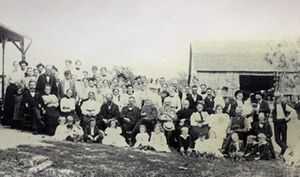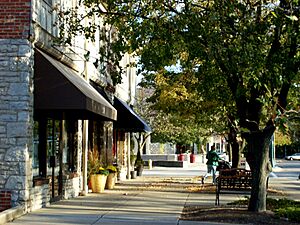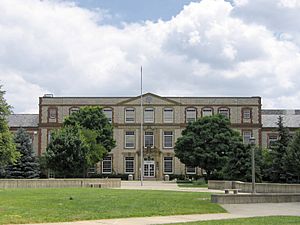Upper Arlington, Ohio facts for kids
Quick facts for kids
Upper Arlington, Ohio
|
|||
|---|---|---|---|

The Upper Arlington Municipal Services Center
|
|||
|
|||
| Motto(s): | |||
| Country | United States | ||
| State | Ohio | ||
| County | Franklin | ||
| Area | |||
| • Total | 9.82 sq mi (25.45 km2) | ||
| • Land | 9.79 sq mi (25.37 km2) | ||
| • Water | 0.03 sq mi (0.08 km2) | ||
| Elevation | 814 ft (248 m) | ||
| Population
(2020)
|
|||
| • Total | 36,800 | ||
| • Density | 3,757.02/sq mi (1,450.53/km2) | ||
| Time zone | UTC-5 (Eastern (EST)) | ||
| • Summer (DST) | UTC-4 (EDT) | ||
| Area code(s) | 614 and 380 | ||
| FIPS code | 39-79002 | ||
| GNIS feature ID | 1075125 | ||
| Website | https://upperarlingtonoh.gov/ | ||
Upper Arlington (often called U.A.) is a city in Franklin County, Ohio, United States. It is located on the northwest side of the Columbus metropolitan area. In 2020, about 36,800 people lived there. The older part of the city, called Old Arlington, is a special historic place.
Contents
History of Upper Arlington
Early Inhabitants and Land Ownership
The area where Upper Arlington is today was first home to the Adena people. They were known for building cone-shaped mounds for burials. Later, the Wyandot lived here. After the Revolutionary War, the U.S. Government gave land to soldiers instead of money. This land was then sold to different farming families in the 1800s.
Founding the City
Two brothers, King and Ben Thompson, were real estate developers. They bought 840 acres of land in 1913. This land was south of what is now Lane Avenue. They first called it the "Country Club District." By 1917, it became known as "Upper Arlington." This name came from its neighbor to the south, Arlington (now Marble Cliff). The Upper Arlington Company started that year.
Planning the City's Layout
The city was planned by landscape architect William Pitkin, Jr. He used a "Garden City" style. This meant streets followed the land's curves and were lined with many trees. This was different from a grid pattern. This design gives the oldest part of Upper Arlington a pleasant, park-like feel. It has many small green spaces.
Camp Willis and City Growth
In 1916, development paused. The National Guard used the area as a training camp called Camp Willis. Thousands of soldiers trained there before going to the Mexican border. The camp closed in September 1916. Development then continued. On March 20, 1918, Upper Arlington officially became a village with 200 people. James T. Miller, the original landowner, became the first mayor. The Mallway, built in the 1920s, was the first shopping area.
City Rules and Expansion
Upper Arlington had rules for its development. These rules helped create open, green spaces and parks. They also made sure homes had large front yards. Businesses and apartments were built in separate areas. Upper Arlington became a city on February 8, 1941. It grew by adding nearby land as its population increased. Most of this growth happened from the late 1940s to the 1960s.
Notable Families and Development
Some of the land added to Upper Arlington was part of Perry Township. Many farm families lived there in the 1800s. One important resident was Pleasant Litchford. He was a former slave who bought his freedom and moved north. He became a respected member of the African-American community. The current high school is on land he owned. Other old farming family names include Kennedy, McCoy, and Richards.
After World War II, many new homes were built north of Lane Avenue. These newer areas had a different look. They often had ranch-style houses and normal street grids. By the 1960s, as the city grew north, houses became larger. The southern part of the city, known as "Old Arlington," was listed as a historic district in 1985.
Geography of Upper Arlington
Upper Arlington is located between two rivers. The Scioto River is to its west. The Olentangy River is a short distance to the east. The city is bordered by Columbus to the north and east. To the south are Marble Cliff and Grandview Heights. Downtown Columbus is to the southeast.
The city is about 800 feet above sea level. Two ravines, which are like small valleys, cut through the city. The Slate Run flows into the Scioto River. The Turkey Run is longer and flows through the Ohio State University Golf Course. The soil in the area is good for farming. The city covers about 9.87 square miles (25.45 square kilometers). Most of this is land, with a small amount of water.
People of Upper Arlington
Population Growth Over Time
Upper Arlington has grown a lot since it was founded.
- In 1920, there were 620 people.
- By 1960, the population had grown to 28,486.
- In 2020, the city had 36,800 residents.
Who Lives in Upper Arlington?
According to the 2010 census:
- The average age of people living in Upper Arlington was 42.8 years old.
- About 93.7% of the people were White.
- About 5.8% of the people were Asian.
- Other groups made up smaller percentages of the population.
Most homes in Upper Arlington are owned by the people who live in them. About 80.83% of homes are owner-occupied. This means that most families own their homes.
Arts and Culture in Upper Arlington
Upper Arlington has a lively arts scene. It has public art, art classes in schools, and outdoor concerts in the summer.

Annual Events and Festivals
The city hosts many family-friendly events throughout the year.
- The Labor Day Arts Festival started in 1966. It brings over 25,000 visitors to Northam Park. People can buy art and crafts from about 200 artists. There are also art activities, performances, and live music.
- The Parks & Recreation Department holds events like Winter Fest, Fall Fest, and Spring Fling.
- There is a free outdoor summer concert series in June and July. These concerts feature local and regional musicians.
Community Celebrations
The Upper Arlington Civic Association (UACA) organizes popular community events.
- They host the annual Fourth of July celebrations. These include a parade and an evening festival called Party in the Park. The festival ends with fireworks.
- UACA also holds an Easter Candy Hunt, a Halloween event called "Golden Bear Scare," and visits with Santa during Christmas. They also have a holiday home decorating contest.
Upper Arlington Public Library
The Upper Arlington Public Library (UAPL) system has three locations. The Main Library is on Tremont Road. There is also the Lane Road Branch and the Miller Park Branch. Before 1967, these libraries were part of the Grandview Heights Public Library. Upper Arlington started its own library system in 1967.
Education in Upper Arlington
The Upper Arlington City School District serves the whole city. The school district is one of the city's largest employers.
Schools in the District
The district has:
- An early education school (Burbank Early Education School).
- Five elementary schools (Wickliffe Progressive, Barrington, Greensview, Tremont, and Windermere).
- Two middle schools (Hastings Middle School and Jones Middle School).
- One high school (Upper Arlington High School).
Jones Middle School is in the old high school building. This building is also where Camp Willis used to be. Upper Arlington High School offers the International Baccalaureate program. The school's mascot is the Golden Bear. This nickname was also given to professional golfer Jack Nicklaus, who went to the school. The high school was recently remodeled in 2021.
Private Schools
There are also private schools in Upper Arlington. These include The Wellington School. There are also two Catholic grade schools, St. Agatha and St. Andrew. Both offer programs for students from kindergarten to 8th grade.
Notable People from Upper Arlington
Many famous people have lived in Upper Arlington.
- John W. Bricker: A U.S. Senator and Ohio Governor.
- Jake Borelli: An actor.
- Cordelia E Cook: The first woman to receive both the Bronze Star Medal and the Purple Heart.
- John Cooper: A football player and coach for Ohio State University.
- Beverly D'Angelo: An actress and singer.
- Nick Foligno: An ice hockey player.
- Woody Hayes: A famous head football coach for the Ohio State Buckeyes.
- Arthur G. James: A surgeon who specialized in treating cancer.
- Abigail Johnston: An Olympic silver-medalist synchronized diver.
- Jack Nicklaus: A world-famous professional golfer.
- William O'Neill: The 59th Governor of Ohio.
- Vivek Ramaswamy: A businessman and political candidate.
- James A. Rhodes: A U.S. state governor who served four terms.
- Randy Skinner: A Broadway Director and Choreographer.
- George Smoot: A Nobel Prize winning astrophysicist.
- Chris Spielman: A professional football player and sports commentator.
- Steve Stivers: A U.S. House Representative.
- Melinda Lou "Wendy" Thomas: A businesswoman and the namesake for Wendy's restaurants.
- Rex Dave Thomas: The founder of Wendy's.
- Jim Tressel: A head football coach and university president.
Sister City
Upper Arlington has one sister city relationship:
 St. Andrews, Scotland, United Kingdom
St. Andrews, Scotland, United Kingdom
See also
 In Spanish: Upper Arlington (Ohio) para niños
In Spanish: Upper Arlington (Ohio) para niños





